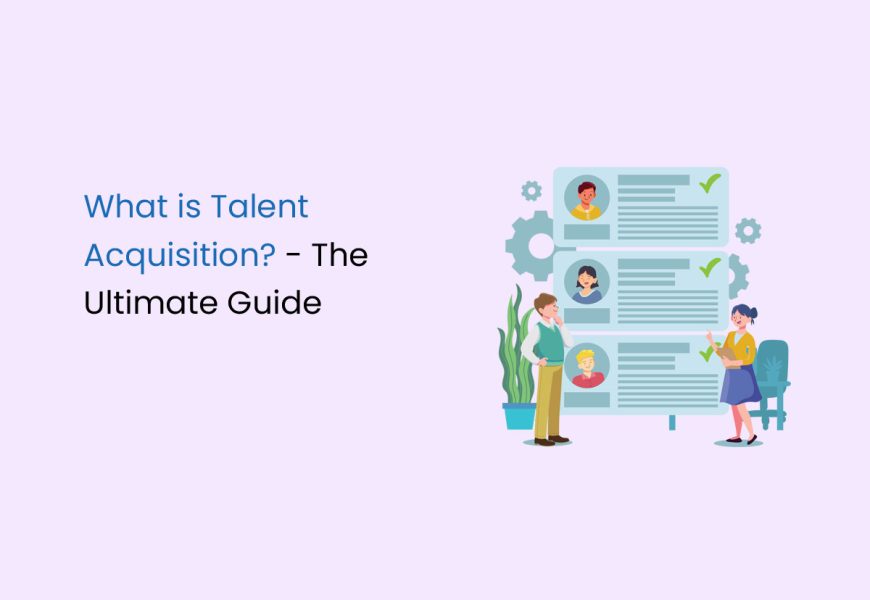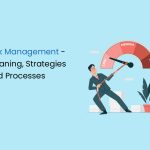In the pursuit of achieving business goals, assembling a skilled team is an absolute necessity. However, acquiring top talent is not random; it demands continuous endeavours for research to find qualified candidates for your team. This ongoing commitment forms the essence of a contemporary talent acquisition practice.
This article explores the strategies and principles essential for understanding talent acquisition in the modern business environment.
What is Talent Acquisition?
Talent acquisition is the intricate process of recognising and securing skilled professionals to meet the specific needs of an organisation. The responsibility of the talent acquisition team extends to the identification, acquisition, assessment, and hiring of candidates to fill vacant positions within the company. Vital components of talent acquisition include shaping employer branding, planning for future workforce needs, fostering diversity in the labour force, and establishing a robust pipeline of potential candidates.
In organisational structures, the talent acquisition team may either operate as part of the Human Resources department or exist independently, collaborating closely with HR. Effective talent acquisition professionals exhibit various skills encompassing strategic sourcing, adept candidate assessment, adherence to compliance and hiring standards, and proficiency in employment branding practices and corporate hiring initiatives. These professionals are pivotal in aligning a company’s workforce with its strategic goals and fostering a dynamic and inclusive organisational culture.
Talent Acquisition vs. Recruitment
It’s not uncommon for people to use the terms “talent acquisition” and “recruitment” interchangeably, given their shared goal of hiring individuals to fill open positions. While both functions have overlapping aspects, they also diverge significantly. Drawing an analogy from the world of sports sheds light on their distinctions. Think of recruitment as signing free agents to meet immediate team needs, while talent acquisition mirrors the comprehensive approach to roster health in the long term. This involves drafting emerging talent, maintaining financial flexibility, fostering a winning team culture through strategic coaching hires, and ensuring sustained success.
In essence, recruiters address immediate vacancies, akin to signing free agents. Conversely, talent acquisition consultants adopt an enduring strategy, identifying specialists, leaders, and potential executives for the organisation. Talent acquisition places a greater emphasis on long-term human resources planning rather than meeting short-term labour demands.
How to Make Talent Acquisition Effective?
Successfully recruiting top-tier talent involves a comprehensive approach that aligns planning and talent acquisition strategies seamlessly across various organisational departments. The goal is to meticulously identify, target, and attract the most qualified candidates for specific roles.
One of the primary responsibilities of talent acquisition teams is to craft and cultivate employer branding, a crucial element in attracting candidates. This branding should provide a clear insight into the company’s culture, reputation, differentiators from competitors, and the products and services it offers.
Beyond initial attraction, talent acquisition teams are entrusted with managing the entire candidate life cycle, from the initial application to the ultimate job offer. This necessitates effective collaboration, transparent communication, and alignment of goals with hiring managers to ensure a smooth and efficient recruitment process.
Moreover, talent acquisition extends beyond recruitment. Teams are also tasked with the retention of essential employees and the ongoing cultivation of morale within the labour force. By focusing on these multifaceted aspects, organisations can foster an environment that attracts top talent and retains and nurtures it for sustained success.
What is the Current Talent Acquisition Journey?
Embarking on the modern talent acquisition process is a multi-faceted journey that unfolds over several weeks or months, entailing a meticulous series of steps as organisations strive to pinpoint and secure qualified candidates for open roles.
Aligning with the Hiring Manager
- Intake Meeting: The process kicks off with a crucial intake meeting, establishing alignment with the hiring manager. Here, insights into the role, the ideal candidate profile, and requisite skills and qualifications are gleaned.
- Sourcing Candidates Together: Collaborative candidate sourcing sessions with the hiring manager provide a tangible glimpse into the talent pool, fostering detailed feedback exchange.
- Ongoing Alignment: Maintaining synchronicity with the hiring manager is a continuous effort throughout the recruitment journey. Regular feedback solicitation and guidance towards favourable hiring outcomes remain paramount. This may involve assisting in drafting impactful social media posts and formulating insightful interview questions.
Crafting Compelling Job Descriptions
- Beyond the Basics: Job descriptions transcend mere listings of responsibilities and qualifications. They evolve into compelling narratives that illuminate what sets the organisation apart.
- Showcasing Uniqueness: Job descriptions become a tool to capture candidates’ attention by highlighting the organisation’s unique attributes — be it growth opportunities, commitment to diversity and inclusion, or sought-after benefits.
- Fostering Transparency: Removing unnecessary qualifications that might deter talented candidates and incorporating pay transparency into job listings enhances appeal. Studies show that 85% of job seekers are more likely to apply when a salary range is provided.
Strategic Candidate Sourcing
- Diverse Channels: Recognizing that exceptional candidates can emerge from various sources, modern talent acquisition teams leverage diverse channels.
- Comprehensive Sourcing Channels: This includes utilising job boards, online platforms, employee referral programs, internal talent pools, engaging with company alumni, and partnering with external networks such as boot camps and conferences.
- Relationship Building: Establishing positive connections with candidates, regardless of the hiring outcome, transforms the database into a valuable source of potential candidates for future roles.
Attracting and Engaging Candidates
- Enticing Skilled Candidates: In a landscape where skilled candidates have abundant choices, the onus is on organisations to captivate them and make their recruitment process worthwhile.
- Building a Strong Employer Brand: The foundation lies in constructing a robust employer brand that showcases the organisation’s unique attributes and values.
- Promoting Company Culture: Actively promoting the company’s distinct culture becomes instrumental in creating an appealing environment for potential candidates.
- Competitive Compensation: Designing a competitive compensation package adds a crucial dimension to the attraction and engagement strategy.
- Candidate Relationship Management: Beyond mere attraction, fostering a positive candidate experience, nurturing leads, and cultivating long-term relationships contribute significantly to the engagement process.
Evaluating Job Candidates
- Strategic Preparation: Modern talent acquisition professionals approach the evaluation stage with meticulous preparation to conduct thorough and fair assessments.
- Defining Key Skills and Performance Indicators: Identifying the three to five most crucial skills for the role and determining key performance indicators guide the creation of targeted interview questions.
- Utilising Assessment Tools: Besides traditional interviews, employing additional tools such as skills tests, personality or cognitive evaluations, and practical demonstrations enhances the evaluation process.
- Structured Selection Process: Implementing a systematic approach to selecting candidates, including the use of tracking software and internal grading systems, ensures clarity and efficiency in decision-making.
- Reference Checks: Validating the top candidate through reference checks offers a final layer of assurance regarding their skills and values.
Extending a Job Offer
- Strategic Communication: The job offer stage is a critical opportunity to secure the candidate’s commitment. Initiating a verbal offer enables a personalised discussion about the candidate’s fit for the role.
- Written Offer Details: Following up with a comprehensive written offer, outlining the total compensation package, and reiterating enthusiasm for extending the offer, adds formality and clarity.
- Onboarding Preparation: As the offer is accepted, the focus shifts to employee onboarding. A seamless onboarding process, initiated with a warm welcome and clear next steps, plays a pivotal role in shaping the new employee relationship.
- Emphasizing Excitement: Throughout the offer and onboarding process, continuously emphasising excitement about the candidate joining the organisation reinforces a positive and welcoming atmosphere.
Effective Talent Acquisition Strategies
Forward-thinking organisations recognise the imperative to continually adapt their talent acquisition strategies to meet evolving opportunities and challenges. The deployment of these strategies is contingent upon factors such as business needs, prevailing pain points in the hiring process, and available resources.
Talent Forecasting
Forward-thinking talent acquisition teams engage in proactive talent forecasting, aligning recruitment plans with the future needs and goals of the organisation. Identifying roles that are challenging to fill, such as those requiring niche skills, specific experiences, or senior leadership, becomes paramount. Prioritising these roles streamlines the hiring process. Anticipating economic shifts, talent acquisition strategies extend beyond hiring full-time employees to encompass contractors, gig workers, part-time employees, and flexible workers. This adaptability addresses dynamic staffing needs effectively.
Talent Pipelining
Modern talent acquisition transcends immediate requirements and embraces a long-term perspective. Implementing robust candidate tracking systems, whether through spreadsheets or specialised software, ensures a comprehensive understanding of potential candidates. Dedicate regular time for talent acquisition activities, including networking, outreach, and relationship-building. This consistent effort lays the groundwork for future roles. Break down silos between HR and talent acquisition teams, encouraging a collaborative approach. Involve the entire organisation in talent acquisition efforts through employee referral programs, incentives for key hires, and public recognition systems. This inclusive strategy accelerates the identification of qualified candidates by aligning team members with organisational hiring needs and future goals.
Crafting a Compelling Image
Ensuring that your organisation’s website, social media profiles, and depiction of company culture resonate not only with your target customers but also with potential candidates.
Unified Branding Efforts: Led by departments such as marketing, communications, or HR, cohesive branding efforts play a pivotal role in capturing the attention of skilled talent and enticing them to consider your organisation.
Skills-Based Hiring
Historically, employers have relied on proxies like education or years of experience, which may inadvertently exclude otherwise qualified candidates.
- Embracing Skills-Centric Evaluation: A more effective paradigm is skills-based hiring, where the focus shifts from pedigree to assessing candidates based on their skills. This involves removing degree requirements from job descriptions and prioritising responsibilities and competencies.
- LinkedIn Insights: Research from LinkedIn underscores the efficacy of skills-based hiring, revealing that employers leveraging skills as a key criterion are 60% more likely to achieve successful hires compared to those who do not prioritise skills in their hiring process.
Candidate Experience
A positive candidate experience is a pivotal factor in not only engaging a wider pool of job seekers but also influencing top-choice candidates to favour your job offer over others. Best-in-class talent acquisition teams prioritise providing a seamless and respectful journey for candidates, extending from pre-application interactions to the onboarding process. This commitment includes transparent communication regarding the hiring process, timely updates, and the facilitation of constructive feedback. By consistently surpassing a candidate’s expectations at every stage, organisations can leave a positive and lasting impression, establishing themselves as employers of choice.
Internal Mobility
Internal mobility emerges as a strategic approach wherein organisations prioritise developing and promoting employees from within rather than seeking external candidates to fill open positions. This proactive strategy begins with the identification of top-performing individuals within the company, followed by dedicated efforts to train and prepare them for increased responsibilities and leadership roles. Establishing a foundation for internal mobility involves initiatives such as offering clear career paths, providing regular and detailed feedback, implementing internal mentorship programs, delivering high-quality employee training, and offering stretch assignments. Regular communication of open roles through internal channels, such as an internal wiki or email, ensures that employees are aware of job opportunities and can express their interest.
Building Innovative and Inclusive Teams
Recognising the value of diverse teams in fostering innovation and creativity, talent acquisition plays a crucial role in supporting an organisation’s overall DEI strategy. While the responsibility of building a diverse team extends beyond talent acquisition, effective initiatives include crafting inclusive job descriptions, actively sourcing from diverse candidate pipelines, and implementing measures to mitigate bias throughout the hiring process. Ensuring that underrepresented candidates experience an inclusive recruitment process is a significant stride toward creating a more equitable workplace.
Talent Analytics
Modern talent acquisition software empowers organisations to adopt a data-driven approach to decision-making through talent analytics. These analytics are important in optimising recruitment processes, enhancing hiring outcomes, and ensuring a favourable return on investment. By leveraging analytics, organisations can gain insights into the effectiveness of different candidate sources, identifying those that yield quality applicants and those that may not justify the allocation of limited resources. This strategic use of metrics guides informed decisions, allowing for the optimal allocation of recruitment marketing budgets to channels that yield the best results.
FAQs on Talent Acquisition
What Skill is Talent Acquisition?
Talent acquisition requires a diverse set of skills, including:
- Recruitment Skills: Identifying and attracting top talent through various sourcing channels.
- Communication Skills: Effective communication is crucial in conveying the organisation's values and opportunities to potential candidates.
- Networking: Building and maintaining professional relationships to tap into talent pools.
- Data Analysis: Utilizing data to track recruitment metrics, evaluate the effectiveness of strategies, and make informed decisions.
Is Talent Acquisition a Good Career?
Talent acquisition can be a rewarding career for individuals who enjoy:
- Building Relationships: Developing connections with candidates and understanding their career aspirations.
- Strategic Thinking: Planning and implementing recruitment strategies aligned with organisational goals.
- Continuous Learning: Staying updated on industry trends, recruitment technologies, and best practices.
- Impact: Contributing directly to the organisation's success by bringing in skilled and suitable talent.





















